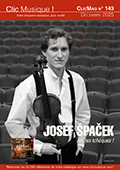 Il faut traverser l’Atlantique à l’heure du triste Trump et gagner le Michigan profond de Jackson afin de reconnaître le savoir et l’érudition de Matthew Aubin, qui réveille la vie précocement interrompue et aujourd’hui oubliée, de Fernande Breilh-Decruck (1896-1954), pour redécouvrir une figure de l’entre-deux guerres français à laquelle Olivier Messiaen rendait hommage lorsqu’il lui dédiait "Chants de Terre et de Ciel" (1938) « avec toute la reconnaissance et le souvenir ému de l’auteur ». On se reportera pour cela à l’excellent site : https://fernandedecruck.fr/biographie/. Les enregistrements proposés par le label suisse Claves offrent une belle opportunité de reconnaitre une compositrice d’exception en dépit des heurts et malheurs de son existence personnelle : Organiste et improvisatrice virtuose, reconnue aux States entre 1928 et 1933, puis simple enseignante au Conservatoire de Toulouse avant de gagner Fontainebleau… Le Concerto de 1932 n’a rien à envier au Concerto de Guy Ropartz (1928) ni, pour sa virtuosité, au "Don Quichotte" de Richard Strauss (1897) ou au Konzertstück de Dohnanyi (1904). Il est ici magnifiquement servi par Jeremy Crosmer dont on appréciera la virtuosité sans faille dans la cadence médiane du premier mouvement. Mitsuru Kubo, dans la Sonate pour Saxophone ou alto (ici) de 1943, le remarquable claveciniste Mahan Esfahani enfin donne une interprétation souveraine de la Suite pour clavecin et orchestre "Les Trianons" (1946) avant que l’auditeur ne soit conquis par le charme et l’ingéniosité compositionnelle des "Clochers de Vienne", Suite de Valses (1935). Tout au long de cet enregistrement, on appréciera l’engagement et la ferveur de Matthew Aubin, du Jackson Symphony Orchestra et de ses solistes, qui contribuent ainsi, avec tous leurs mérites, à offrir à Fernande Decruck les lauriers lui permettant d’inscrire son nom sur leur couronne méritée plus durablement que sur les pétales de roses faillibles auxquels sont cantonnées nombre de compositrices. (Jacques-Philippe Saint-Gerand)  The career of the French composer Fernande Decruck showed promise from an early age when she won several prizes at the Conservatoire National Supérieur de Paris (harmony, fugue, piano). As an assistant professor of harmony, she trained many students, including one who became very famous and who later dedicated a score to her “To Fernande Decruck, with all the gratitude and fond memories of the author - O. Messiaen ”. From 1926, the year of his appointment as organ teacher, Marcel Dupré introduced her to improvisation, a talent which earned a concert tour of organ in the United States at the end of 1928. She later gave solo recitals in the great auditoriums of New York. The trajectory of Decruck the composer can be traced through her early works, which give prominence to the organ (her instrument), saxophone and double bass (her husband’s instruments). The Decrucks lived in New York for several years. Her husband Maurice played double bass and saxophone for the New York Philharmonic under the direction of Arturo Toscanini. Decruck’s American period saw the birth of numerous compositions for piano, organ, orchestra and a concerto for cello and orchestra as well as many works for a wide range of wind instruments, notably for saxophone. In 1937, Fernande Decruck moved to Toulouse alone with her three children. She worked as a professor at the Toulouse Conservatory. Beginning in 1942, she devoted herself entirely to composition, notably writing a harp concerto, Poème héroïque, and the Sonata in C# for saxophone. She officially divorced Maurice in 1950 which led to financial difficulty. She ended her career as a professor of harmony at the Fontainebleau Conservatory. A series of health problems led to her untimely death at the age of 57.
 |
